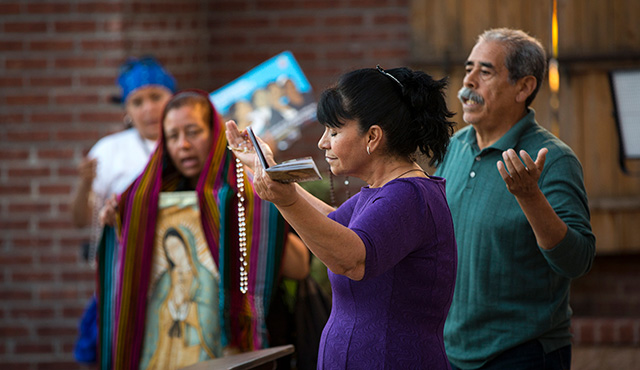Using beads in meditation is an ancient practice of many faiths. For Catholics, praying with the rosary is said to have begun with St. Dominic in his preaching many hundreds of years ago.
Some traditions hold that St. Dominic was asked by Our Lady to pray the rosary in his efforts to defeat the Albigensian Heresy in France, yet certain parts of the rosary are known to have been prayed before St. Dominic’s time.
The rosary’s role as a meditation aid for the laity continues today. In fact, rosary is Latin for ‘garland of roses,’ a fitting tribute to Mary.
We pray the rosary alone and in groups; rosaries are often said upon a loved one’s death in the days before a funeral. October is the month of the Rosary and Oct. 7 is the memorial to Our Lady of the Rosary, dedicated by St. Pius V, who credited a victory over the invading Turks to the intercession of Mary through the rosary.
“Mary offered the rosary to the faithful as a method or practice that yields fruit,” explains Katie Dawson, director of Parish Faith Formation for the Diocese of Orange. “It has a privileged place in our Catholic practices.”
Learning to pray the rosary often begins at home when children are young. “Even done badly the rosary is still worth doing, and that’s what makes it such a good prayer for families,” Dawson notes. “It can be adapted to the ages of children. One or two mysteries may be told with a decade or two of the rosary as a family prayer.”
The benefits of praying the rosary, Dawson says, are that it helps develop spiritual discipline in our lives that fosters a Catholic imagination. “The rosary keeps the story of Jesus in our imagination to recall historic events that inform our faith.”
Repetition of stories embedded in our memories enables us to meditate deeply, Dawson notes. “The rosary is the presentation of the entire story of our faith using all four of the holy mysteries.”
Learning to pray the rosary
For those who don’t learn the rosary from their parents, many tutorials are available online. The rosary consists of recognizable prayers; each rosary begins with the Apostle’s Creed, one Our Father, three Hail Marys, often offered for the Pope’s intentions and the virtues of faith, hope and charity, and a Glory Be. Then prayer moves on to the five decades of a single set of mysteries, each including one Our Father, 10 Hail Marys and a Glory Be.
The Catholic Church has set aside rosary days to help in praying the rosary. The cycle of the rosary follows the rhythm of the liturgical year observed by the Catholic Church.
Sunday Glorious Mysteries of the rosary
Monday Joyful Mysteries of the rosary
Tuesday Sorrowful Mysteries of the rosary
Wednesday Glorious Mysteries of the rosary
Thursday Luminous Mysteries of the rosary.
Friday Sorrowful Mysteries of the rosary
Saturday Joyful Mysteries of the rosary.
On Sundays during the Christmas season, the Joyful Mysteries are said; during Sundays in the Lenten season, the Sorrowful Mysteries are said.
The joyful mysteries include: The Annunciation, the Visitation, the Birth of Jesus, the Presentation in the Temple and Finding the Child in the Temple.
The sorrowful mysteries include: The Agony in the Garden, the Scourging at the Pillar, the Crowning with Thorns, the Carrying of the Cross, and the Crucifixion.
The glorious mysteries include: The Resurrection, the Ascension, the Descent of the Holy Spirit, the Assumption and the Coronation of Our Lady as Queen of Heaven and Earth.
The luminous mysteries include: The Baptism of Our Lord at the Jordan, the Wedding Feast at Cana, the Proclamation of the Kingdom, the Transfiguration and the Institution of the Holy Eucharist.

